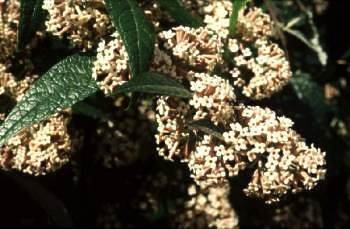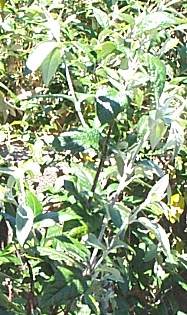Buddleja auriculata
Buddleja auriculata Benth.
Family: Scrophulariaceae
Common names: Weeping Sage (Eng.), Treursalie (Afr.), Utile (isiXhosa)
SA Tree No: 636.5
Introduction

Description
Description
This shrub or small tree has beautiful glossy foliage: its leaves are deep-green above and silver below. Profuse spikes of tiny, tubular, sweetly-scented cream, orange or pinkish flowers appear in July (mid-winter) to September (spring) on the ends of the 'weeping' branches. The fruit is a tiny, creamy brown capsule that splits at the tip (June to September).
Distribution and habitat
Distribution description
This shrub occurs naturally on mountain slopes, in rocky ravines, and on forest margins, from Eastern Cape to Zimbabwe.

Derivation of name and historical aspects
History
The genus is named after the Rev. Adam Buddle (1660-1715), an English botanist, and auriculata means having an ear-like appendage and refers to the stipule between the leaves which resembles a small ear. There are seven species of Buddleja in South Africa. They are mostly shrubby and can sometimes become small trees. Among those making good garden plants are Buddleja saligna and Buddleja salvifolia .
Ecology
Ecology
The flowers attract many butterflies and other insects, which in turn become food for insectivorous birds like the Southern Boubou and Cape Robin.

Growing Buddleja auriculata
Grow
This plant is easily propagated from hardwood cuttings. Shapely and graceful (4 × 4 m) Buddleja auriculata looks particularly attractive planted near water, perhaps next to a large dam or pond. The thick foliage could provide safe shelter for birds. Use it in a large mixed shrub border, or to form a screen, or as an informal hedge. It is suitable for medium to large gardens, any place that can accommodate its spread. This plant performs well in the Pretoria area, forming a neatish, dense, weeping shrub, but it does not fare as well in the Lowveld. It grows well in the Western Cape too, often flowering earlier and growing more upright.
Frost- and drought-resistant, this fast-growing shrub will probably grow well in most soils, but add plenty of compost and fertilizer (slow-release 3:2:1 or 3:1:5), and water regularly, for better results. Give less water in winter (June to end August). It tolerates pruning well, but this is usually unnecessary if enough room has been allowed for it to spread comfortably. A little shade will not be a problem, but it prefers a sunny spot. It can handle temperatures ranging from about -5°C to 38°C.
References
- COATES-PALGRAVE, K. 1988. Trees of southern Africa, edn 2. Struik, Cape Town.
- JOFFE, P. 2001. Creative gardening with indigenous plants-a South African guide. Briza Publications, Pretoria.
- PALMER, E. & PITMAN, N. 1972. Trees of southern Africa. Balkema, Cape Town.
- POOLEY, E. 1993. The complete guide to trees of Natal, Zululand and Transkei. Natal Flora Publications Trust.
- VAN WYK, B. & VAN WYK, P. 1997. Field guide to the trees of southern Africa. Struik, Cape Town.
Credits
Pitta Joffe
Pretoria National Botanical Garden
November 2002
Plant Attributes:
Plant Type: Scrambler, Shrub, Tree
SA Distribution: Eastern Cape, KwaZulu-Natal, Limpopo, Mpumalanga
Soil type: Sandy, Clay, Loam
Flowering season: Spring, Winter
PH: Acid, Neutral
Flower colour: Pink, Cream, Yellow, Orange
Aspect: Full Sun, Morning Sun (Semi Shade), Afternoon Sun (Semi Shade)
Gardening skill: Easy
Special Features:
Horticultural zones











Rate this article
Article well written and informative
Rate this plant
Is this an interesting plant?
Login to add your Comment
Back to topNot registered yet? Click here to register.